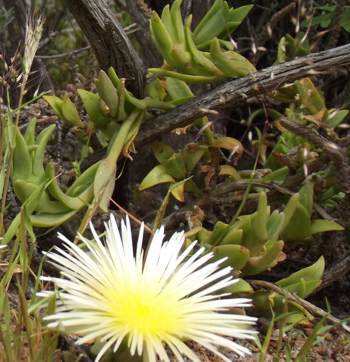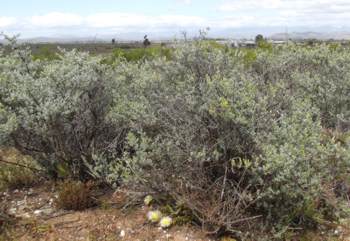Mesembryanthemum varians
Mesembryanthemum varians Haw.
Family: Aizoaceae
Common names: salt mesemb, skeleton plant (English); soutvygie (Afrikaans)
Introduction
Mesembryanthemum varians was previously known as Sceletium varians. It is known to have few medicinal properties — unlike Mesembryathemum tortuosum (previously Sceletium tortuosum). It makes up for it by showcasing its much bigger flowers in spring.

Description
Description
Mesembryanthemum varians is a low-growing, scrambling and short-lived perennial. The branches may become woody and thick with age. The succulent leaves are narrow and flat, not imbricate and to 20 mm long. The tips of the leaves are recurved, with bladder cells appearing as small dots.

Mesembryanthemum varians has white to pale yellow flowers, 40mm in diameter. The reproductive parts of the flower are concealed by the filamentous staminodes. The fruit, a capsule with valve wings, has 4 to 5 locules. Mesembryanthemum varians flowers between August and October, during which growth is very fast. Growth slows down and the plants become skeleton-like during February to June.
Conservation Status
Status
The Red List status of Mesembryanthemum varians is Vulnerable [VU] according to Victor & Helme (2009). Populations are declining due to vineyard expansion and urban development. A few areas in the Worcester region have already been declared as a reserve to protect this species from becoming threatened. The Karoo Desert National Botanical Garden is also in the process of identifying populations for conservation.
Distribution and habitat
Distribution description
The distribution range of Mesembryanthemum varians lies between Worcester and Robertson in the Western Cape. It usually grows on the lowlands, underneath shrubs and on shale flats.

Derivation of name and historical aspects
History
The genus name relates to the way the flowers open at noon. When the leaves of Mesembryanthemum varians dry out, they become skeleton-like, hence the common name, skeleton plant. This genus occurs in areas of the Klein, Great and Upper Karoo.
Ecology
Ecology
The main pollinators of Mesembryanthemum varians are bees, but many other insects have also been spotted on this species. Mesembryanthemum varians has one of the biggest flowers in the genus, thus attracting many pollinators.
The leaves are succulent to store water and food. During the dormant season, the mature leaves dry out, becoming skeleton-like, and surround the younger leaves, leaving them cooler and protecting them from the sun.
These plants are also famous for growing underneath larger shrubs for protection from the harsh sun. During the growing season, they will creep from beneath the larger shrubs and expose their flowers to pollinators.
Like many species in this family, the capsules of Mesembryanthemum varians are dependent on rain for seed dispersal. When it rains, the capsules open and the rain drops splash the seeds out of the locules. These seeds end up underneath larger plants, where they germinate when conditions are favourable. During warmer conditions, the capsule will close again, thus protecting the remaining seeds.

Uses
Use
Some members of the genus are known for their medicinal properties, which include elevation of mood, decreasing stress and also treatment of other ailments of the human body. Mesembryanthemum varians is believed to have none or few of the medicinal properties that the commercialised Sceletium tortuosum. Mesembryanthemum varians will, however, do well in rockeries and water-wise gardens. They tend to love partial shade and can also be grown in pots or as a bonsai.
Growing Mesembryanthemum varians
Grow
Mesembryanthemum varians can be grown from seed and cuttings. Sow seeds in autumn to winter. Use a shallow seedling tray with a mixture of coarse river sand (60%) and sieved compost (40%). Do not compact the soil in the seedling tray. Sow seed evenly onto the mixture and cover with a fine layer of sand. Keep soil medium moist using a mist sprayer. Seeds will germinate within two weeks.
Take cuttings during the active growing period (spring). Use the soft growth tips of the plant (5 cm) and insert in coarse river sand. A rooting hormone can also be used for optimum results. Water cuttings using a fine mist sprayer. Always use sterilised equipment and soil mediums. Germinated seedlings and rooted cuttings need to be transplanted in a medium with a higher compost ratio. Place transplanted plants in a sunny area.
Mesembryanthemum varians can be used in rockeries and water-wise gardens. They do well in shaded areas or underneath larger shrubs, especially shrubs from the Karoo areas. These plants can also be grown in pots and manipulated to a bonsai. Flowering takes place in spring. No pests have been observed on Mesembryanthemum varians.
References
- MANNING, J. & GOLDBLATT, P. 2012. Plants of the Greater Cape Floristic Region 1: The Core Cape Flora . Strelitzia 29. South African National Biodiversity Institute, Pretoria.
- SMITH, G.F., VAN JAARSVELD, E., HAMMER, S., CHESSELET, P., HARTMAN, H., BURGOYNE, P., VAN WYK, B.-E. & KURZWEIL, H. 1998. Mesembs of the World . Briza Publications, Pretoria.
- VAN WYK, B.-E. & GERICKE, N. 2000. People's plants: a guide to useful plants of southern Africa . Briza Publications, Pretoria.
- VICTOR, J.E. & HELME, N.A. 2009. Sceletium varians. In D. Raimondo, L. von Staden, W. Foden, J.E. Victor, N.A. Helme, R.C. Turner, D.A. Kamundi & P.A. Manyama (Eds), Red List of South African Plants 2009. Strelitzia 25. South African National Biodiversity Institute, Pretoria.
Credits
Ricardo Riddles
Karoo Desert National Botanical Garden
July 2014
Plant Attributes:
Plant Type: Succulent
SA Distribution: Western Cape
Soil type:
Flowering season: Spring, Winter
PH:
Flower colour: White, Yellow
Aspect: Full Sun, Shade
Gardening skill:
Special Features:
Horticultural zones







Rate this article
Article well written and informative
Rate this plant
Is this an interesting plant?
Login to add your Comment
Back to topNot registered yet? Click here to register.